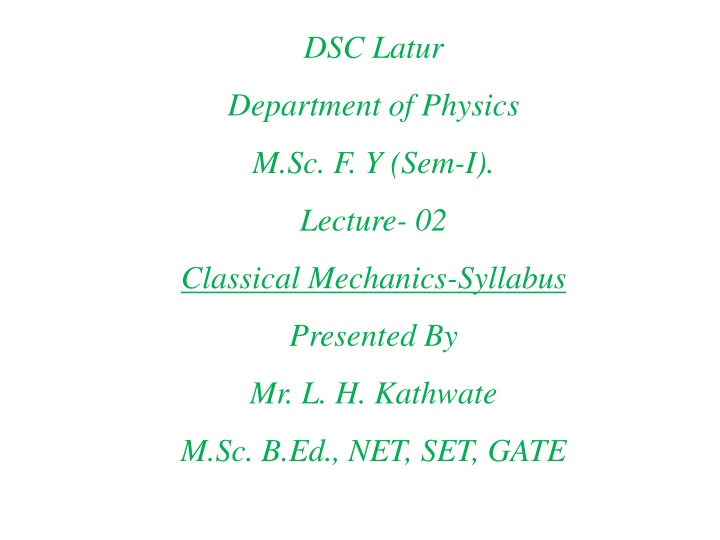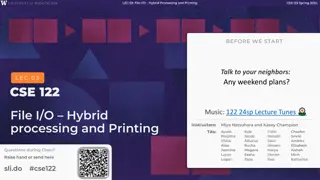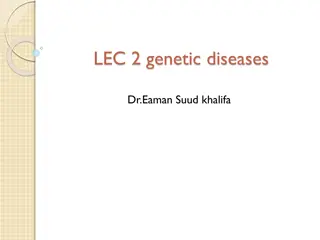
Exploring Classical Mechanics: Principles and Formulations
Delve into the world of classical mechanics covering elementary principles, Lagrangian and Hamiltonian formulations, and more. Understand the core differences between classical and quantum mechanics while studying the motion of physical objects under various interactions.
Download Presentation

Please find below an Image/Link to download the presentation.
The content on the website is provided AS IS for your information and personal use only. It may not be sold, licensed, or shared on other websites without obtaining consent from the author. If you encounter any issues during the download, it is possible that the publisher has removed the file from their server.
You are allowed to download the files provided on this website for personal or commercial use, subject to the condition that they are used lawfully. All files are the property of their respective owners.
The content on the website is provided AS IS for your information and personal use only. It may not be sold, licensed, or shared on other websites without obtaining consent from the author.
E N D
Presentation Transcript
DSC Latur Department of Physics M.Sc. F. Y (Sem-I). Lecture- 02 Classical Mechanics-Syllabus Presented By Mr. L. H. Kathwate M.Sc. B.Ed., NET, SET, GATE
PHY 102 Classical Mechanics Credits: 04 Number of lecture: 60 Total Marks: 100 [MSA: 25 (T1+T2+HA=10+10+5) & ESA: 75]
What is mechanics? Mechanics is a branch of physics which deals with study of physical objects which is in motion under the influences of internal and external interaction. Types of Mechanics Classical Mechanics Quantum Mechanics Statistical Mechanics
What is the difference between classical mechanics and quantum mechanics? In classical mechanics, objects exist in a specific place at a specific time. However, in quantum mechanics, objects instead exist in a haze of probability; they have a certain chance of being at point A, another chance of being at point B and so on.
Classical Mechanics: The mechanics which is based on Newton s laws of motion and alternatively developed by Lagrangian Hamiltonian and others is called classical mechanics.
Syllabus Module I: Elementary Principles (15 Hours) Module II: Lagrangian Formulation (15 Hours) Module III: Hamiltonian Formulation and Central Force (15 Hours) Module IV: Rigid body dynamics and small oscillations (15 Hours)
Module-I: Elementary Principles Review of Newtonian mechanics; Inertial reference frame; Galilean transformations; Motion of a charged particle in electromagnetic field; Conservative and non-conservative forces; Mechanics of a single particle; Mechanics of a System of particles; Motion in a resistive medium; Constraints and its types; Generalized coordinates, cyclic coordinates and degrees of freedom; Virtual displacement and virtual work; D Alembert s principle.
Module-II: Lagrangian Formulation Lagrangian equation of motion from D Alembert s principle, procedure for formation of Lagrange s equation; Variation technique; Generalized momenta and cyclic coordinates; Kinetic energy in terms of generalized coordinates; Jacobi integral; Jacobi integral in terms of kinetic energy; Rayleigh s dissipation function; Gauge transformation for Lagrangian; Symmetry properties and conservation laws; Invariance of Lagrangian equations under Galilean transformation; Variational principle; Derivation of Lagrangian equation from Variational principle.
Module-III: Hamiltonian Formulation and Central Force Part I Hamiltonian Formulation Transformation from Lagrangian to Hamiltonian; Derivation of Hamiltonian equations of motion from Hamiltonian principle; Variation technique; Principle of least action; Canonical transformation; Condition for a transformation to be Canonical; Poisson brackets; Properties of Poisson s bracket; Poisson s bracket of Canonical variables; Jacobi identity; Poisson s theorem; Invariance of Poisson s bracket under canonical transformation; Hamilton-Jacobi method.
Part-II Small oscillations Potential energy and equilibrium; Stable and unstable equilibriums; Small oscillations in a system with one degree of freedom; small oscillations in a system with more than one degree of freedom; Normal coordinates; Normal modes and normal frequencies of vibration
Module-IV: Rigid body dynamics and small oscillations Part-I Rigid body dynamics Coordinate systems; Euler s angles; Angular momentum and inertia tensor; Principle axes; Components of angular velocity; Rotational kinetic energy of a body; Euler s equation of motion for a rigid body; Torque free motion of a rigid body. Part-II Small oscillations Potential energy and equilibrium; Stable and unstable equilibriums; Small oscillations in a system with one degree of freedom; small oscillations in a system with more than one degree of freedom; Normal coordinates; Normal modes and normal frequencies of vibration
Reference books: 1. Classical Mechanics by J. C. Upadhyaya, Himalaya Publishing House, New Delhi 2. Classical Mechanics by V. B Bhatia, Joag, Tata Mc Graw Hill Publishing Co. Ltd., New Delhi 3. Classical Mechanics by P. V. Panat, Joag, Tata Mc Graw Hill Publishing Co. Ltd., New Delhi 4. Classical Mechanics by S. L Gupta, V Kumar and H. V Sharma Pragati Prakashan Meerut. 5. Classical Mechanics by Suresh Chandra, Narosa Publishing House, New Delhi 6. Classical Mechanics by N. C. Rana and P. S. Joag, Tata Mc Graw Hill Publishing Co. Ltd.,New Delhi
Question Paper Pattern Question Paper Pattern End Semester Assessment End Semester Assessment Hrs Total Marks: 75 -------------------------------------------------------------------------------------------------------- -------------------------------------------------------------------------------------------------------- Time: 03 Time: 03 Hrs Total Marks: 75 Question 1 Single long questions 15 marks OR Two sub-questions (a and b of 8 and 7 marks) 15 marks (Note: This question will be based on Module I) Question 2 Single long questions 15 marks OR Two sub-questions (a and b of 8 and 7 marks) 15 marks (Note: This question will be based on Module II)
Question 3 Single long questions 15 marks OR Two sub-questions (a and b of 8 and 7 marks) 15 marks (Note: This question will be based on Module III) Question 4 Single long questions 15 marks OR Two sub-questions (a and b of 8 and 7 marks) 15 marks (Note: This question will be based on Module III) Question 5 Write Short Notes on ANY THREE (each of 5 marks) 15 marks a. ------------------ b. ------------------ c. ------------------ d. ------------------ (Note: This question shall be based on entire syllabus and must have one sub-question from each of the module) ***************
Question Paper Pattern (MCQ ) End Semester Assessment Time: 01 Hrs Total Marks: 40 ------------------------------------------------------------------------ There are total 50 MCQ types questions out of which only 40 question need to be solved.



![Lec [2] Health promotion](/thumb/274962/lec-2-health-promotion-powerpoint-ppt-presentation.jpg)